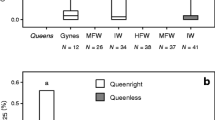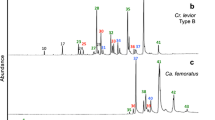Abstract
Chemical communication is crucial for the organization of social insect colonies. However, with the heavy use of one communication modality, problems may arise such as the interference of different types of information. This study investigated how information about fertility and colony membership is integrated in the ant Camponotus floridanus. We introduced into mature, queenright colonies (a) the nestmate queen, (b) a nestmate worker, (c) a foreign, high-fertility queen, (d) a foreign, low-fertility queen, and (e) a foreign worker. As expected, workers did not attack their nestmate queen or a nestmate worker but responded aggressively to foreign workers and foreign, low-fertility queens. Surprisingly, workers did not attack foreign, high-fertility queens. Chemical analysis demonstrated that the cuticular hydrocarbon profile of C. floridanus encodes information about fertility status in queens and workers and colony membership in workers. We suggest that ants respond to this information in the cuticular hydrocarbon profile: individuals with strong fertility signals are accepted regardless of their colony membership, but individuals without strong fertility signals are tolerated only if their cuticular hydrocarbon profile matches that of colony members. Learning how social insects respond to multiple types of information presented together is critical to our understanding of the recognition systems that permit the complex organization of social insect colonies.



Similar content being viewed by others
References
Akino T, Yamamura K, Wakamura S, Yamaoka R (2004) Direct behavioral evidence for hydrocarbons as nestmate recognition cues in Formica japonica. Appl Entomol Zool 39:381–387. doi:10.1303/aez.2004.381
Arthur CL, Pawliszyn J (1990) Solid phase microextraction with thermal desorption using fused silica optical fibers. Anal Chem 62:2145–2148. doi:10.1021/ac00218a019
Bhatkar A, Whitcomb WH (1970) Artificial diet for raising various species of ants. Fla Entomol 53:229–232
Bonavita-Cougourdan A, Clement JL, Lange C (1993) Functional subcaste discrimination (foragers and brood-tenders) in the ant Camponotus vagus Scop.: polymorphism of cuticular hydrocarbon patterns. J Chem Ecol 19:1461–1477. doi:10.1007/BF00984890
Bourke AFG, Franks NR (1995) Social evolution in ants. Princeton University Press, Princeton
Brandstaetter A, Endler A, Kleineidam C (2008) Nestmate recognition in ants is possible without tactile interaction. Naturwissenschaften 95:601–608. doi:10.1007/s00114-008-0360-5
Carlin NF, Hölldobler B (1986) The kin recognition system of carpenter ants (Camponotus spp.) 1. Hierarchical cues in small colonies. Behav Ecol Sociobiol 19:123–134. doi:10.1007/BF00299947
Carlin NF, Hölldobler B (1987) The kin recognition system of carpenter ants (Camponotus spp.) 2. Larger colonies. Behav Ecol Sociobiol 20:209–217. doi:10.1007/BF00299735
Clarke KR, Warwick RM (2001) Change in marine communities: an approach to statistical analysis and interpretation, 2nd edn. PRIMER-E, Plymouth
Cournault L, de Biseau J-C (2009) Hierarchical perception of fertility signals and nestmate recognition cues in two dolichoderine ants. Behav Ecol Sociobiol 63:1635–1641. doi:10.1007/s00265-009-0769-7
Cuvillier-Hot V, Cobb M, Malosse C, Peeters C (2001) Sex, age, and ovarian activity affect cuticular hydrocarbons in Diacamma ceylonense, a queenless ant. J Insect Physiol 47:485–493. doi:10.1016/S0022-1910(00)00137-2
D'Ettorre P (2008) Multiple levels of recognition in ants: a feature of complex societies. Biological Theory 3:108–113. doi:10.1162/biot.2008.3.2.108
D'Ettorre P, Heinze J, Schulz C, Francke W, Ayasse M (2004) Does she smell like a queen? Chemoreception of a cuticular hydrocarbon signal in the ant Pachycondyla inversa. J Exp Biol 207:1085–1091. doi:10.1242/jeb.00865
Denis D, Blatrix R, Fresneau D (2006) How an ant manages to display individual and colonial signals by using the same channel. J Chem Ecol 32:1647–1661. doi:10.1007/s10886-006-9099-7
Dietemann V, Peeters C, Liebig J, Thivet V, Hölldobler B (2003) Cuticular hydrocarbons mediate discrimination of reproductives and nonreproductives in the ant Myrmecia gulosa. Proc Natl Acad Sci USA 100:10341–10346. doi:10.1073/pnas.1834281100
Endler A, Liebig J, Schmitt T, Parker JE, Jones GR, Schreier P, Hölldobler B (2004) Surface hydrocarbons of queen eggs regulate worker reproduction in a social insect. Proc Natl Acad Sci USA 101:2945–2950. doi:10.1073/pnas.0308447101
Endler A, Liebig J, Hölldobler B (2006) Queen fertility, egg marking and colony size in the ant Camponotus floridanus. Behav Ecol Sociobiol 59:490–499. doi:10.1007/s00265-005-0073-0
Fletcher DJC, Blum MS (1981) Pheromonal control of dealation and oogenesis in virgin queen fire ants. Science 212:73–75. doi:10.1126/science.212.4490.73
Gadau J, Heinze J, Hölldobler B, Schmid M (1996) Population and colony structure of the carpenter ant Camponotus floridanus. Mol Ecol 5:785–792. doi:10.1111/j.1365-294X.1996.tb00374.x
Greene MJ, Gordon DM (2003) Social insects: cuticular hydrocarbons inform task decisions. Nature 423:32. doi:10.1038/423032a
Greene MJ, Gordon DM (2007) Structural complexity of chemical recognition cues affects the perception of group membership in the ants Linephithema humile and Aphaenogaster cockerelli. J Exp Biol 210:897–905. doi:10.1242/jeb.02706
Guerrieri FJ, Nehring V, Jørgensen CG, Nielsen J, Galizia CG, d'Ettorre P (2009) Ants recognize foes not friends. Proc R Soc B 276:2461–2468. doi:10.1098/rspb.2008.1860
Hefetz A (2007) The evolution of hydrocarbon pheromone parsimony in ants (Hymenoptera: Formicidae)—interplay of colony odor uniformity and odor idiosyncrasy. Myrmecological News 10:59–68
Heinze J, Keller L (2000) Alternative reproductive strategies: a queen perspective in ants. Trends Ecol Evol 15:508–512. doi:10.1016/S0169-5347(00)01995-9
Helanterä H, Sundström L (2007) Worker policing and nest mate recognition in the ant Formica fusca. Behav Ecol Sociobiol 61:1143–1149. doi:10.1007/s00265-006-0327-5
Hölldobler B, Wilson EO (1990) The ants. Harvard University Press, Cambridge, MA
Howard RW, Blomquist GJ (1982) Chemical ecology and biochemistry of insect hydrocarbons. Annu Rev Entomol 27:149–172. doi:10.1146/annurev.en.27.010182.001053
Howard RW, Blomquist GJ (2005) Ecological, behavioral, and biochemical aspects of insect hydrocarbons. Annu Rev Entomol 50:371–393. doi:10.1146/annurev.ento.50.071803.130359
Kikuchi T, Tsuji K, Ohnishi H, Le Breton J (2007) Caste-biased acceptance of non-nestmates in a polygynous ponerine ant. Anim Behav 73:559–565. doi:10.1016/j.anbehav.2006.04.015
Lahav S, Soroker V, Hefetz A, Vander Meer R (1999) Direct behavioral evidence for hydrocarbons as ant recognition discriminators. Naturwissenschaften 86:246–249. doi:10.1007/s001140050609
Lavine BK, Morel L, Vander Meer RK, Gunderson RW, Han JH, Bonanno A, Stine A (1990) Pattern recognition studies in chemical communication: nestmate recognition in Camponotus floridanus. Chemometr Intell Lab Syst 9:107–114. doi:10.1016/0169-7439(90)80057-D
Le Conte Y, Hefetz A (2008) Primer pheromones in social hymenoptera. Annu Rev Entomol 53:523–542. doi:10.1146/annurev.ento.52.110405.091434
Liebig J (2010) Hydrocarbon profiles indicate fertility and dominance status in ant, bee, and wasp colonies. In: Blomquist GJ, Bagnères AG (eds) Insect hydrocarbons: biology, biochemistry, and chemical ecology. Cambridge University Press, Cambridge, UK, pp 254–281
Liebig J, Peeters C, Oldham NJ, Markstädter C, Hölldobler B (2000) Are variation in the cuticular hydrocarbons of queens and workers a reliable signal of fertility in the ant Harpegnathos saltator? Proc Natl Acad Sci USA 97:4124–4131. doi:10.1073/pnas.97.8.4124
Lopez-Vaamonde C, Koning JW, Brown RM, Jordan WC, Bourke AFG (2004) Social parasitism by male-producing reproductive workers in a eusocial insect. Nature 430:557–560. doi:10.1038/nature02769
Martin SJ, Drijfhout F (2009) Nestmate and task cues are influenced and encoded differently within ant cuticular hydrocarbons. J Chem Ecol 35:368–374. doi:10.1007/s10886-009-9612-x
Martin SJ, Vitikainen E, Helanterä H, Drijfhout FP (2008) Chemical basis of nest-mate discrimination in the ant Formica exsecta. Proc R Soc B 275:1271–1278. doi:10.1098/rspb.2007.1708
Monnin T (2006) Chemical recognition of reproductive status in social insects. Ann Zool Fenn 43:515–530
Monnin T, Malosse C, Peeters C (1998) Solid-phase microextraction and cuticular hydrocarbon differences related to reproductive activity in queenless ant Dinoponera quadriceps. J Chem Ecol 24:473–490. doi:10.1023/A:1022360718870
Morel L, Vander Meer RK, Lavine BK (1988) Ontogeny of nestmate recognition cues in the red carpenter ant (Camponotus floridanus). Behav Ecol Sociobiol 22:175–183. doi:10.1007/BF00300567
Ozaki M, Wada-Katsumata A, Fujikawa K, Iwasaki M, Yokohari F, Satoji Y, Nisimura T, Yamaoka R (2005) Ant nestmate and non-nestmate discrimination by a chemosensory sensillum. Science 309:311–314. doi:10.1126/science.1105244
Peeters C, Liebig J (2009) Fertility signaling as a general mechanism of regulating reproductive division of labor in ants. In: Gadau J, Fewell J (eds) Organization of insect societies: from genome to socio-complexity. Harvard University Press, Cambridge, MA, pp 220–242
Peeters C, Monnin T, Malosse C (1999) Cuticular hydrocarbons correlated with reproductive status in a queenless ant. Proceedings of the Royal Society of London B 266:1323–1327. doi:10.1098/rspb.1999.0782
Sanetra M, Crozier RH (2002) Daughters inherit colonies from mothers in the ‘living fossil’ ant Nothomyrmecia macrops. Naturwissenschaften 89:71–74. doi:10.1007/s00114-001-0288-5
Smith A, Hölldobler B, Liebig J (2009) Cuticular hydrocarbons reliably identify cheaters and allow enforcement of altruism in a social insect. Curr Biol 19:78–81. doi:10.1016/j.cub.2008.11.059
Vander Meer RK, Morel L (1998) Nestmate recognition in ants. In: Vander Meer RK, Breed MD, Espelie K, Winston ML (eds) Pheromone communication in social insects: ants, wasps, bees, and termites. Westview, Boulder, pp 79–103
Vargo EL (1992) Mutual pheromonal inhibition among queens in polygyne colonies of the fire ant Solenopsis invicta. Behav Ecol Sociobiol 31:205–210. doi:10.1007/BF00168648
Acknowledgments
We thank A. Endler for collecting founding queens in 2002 and A. B. Roddy, A. G. Dolezal, P. D'Ettorre, and three anonymous reviewers for their comments on the manuscript. DM was supported by a National Science Foundation predoctoral fellowship. All experiments were conducted in accordance with American statutes governing research. The authors declare that they have no conflict of interest.
Author information
Authors and Affiliations
Corresponding author
Additional information
Communicated by O. Rueppell
Rights and permissions
About this article
Cite this article
Moore, D., Liebig, J. Mixed messages: fertility signaling interferes with nestmate recognition in the monogynous ant Camponotus floridanus . Behav Ecol Sociobiol 64, 1011–1018 (2010). https://doi.org/10.1007/s00265-010-0916-1
Received:
Revised:
Accepted:
Published:
Issue Date:
DOI: https://doi.org/10.1007/s00265-010-0916-1




